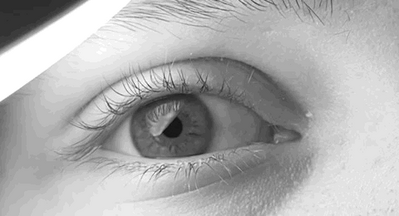Nystagmus
Original Editor - Lucinda hasmpton
Top Contributors - Lucinda hampton, Kim Jackson, Alyssa Brooks-Wells and Uchechukwu Chukwuemeka
Introduction[edit | edit source]
Nystagmus refers to rapid involuntary movements that may cause one or both eyes to move from side to side, up and down or around in circles.[1] The nystagmus may be defined is by the type of movement observed.
- “jerk” nystagmus is slow in one direct and fast in the other
- “pendular” nystagmus is the same speed in both directions
- “rotary nystagmus” has the rotating on the Z-Axis[2]
These movements can reduce vision, affect depth perception, balance, and coordination[3]
Nystagmus itself cannot currently be cured, but some underlying conditions can be treated, especially childhood cataracts and strabismus and there are therapies for some neurological conditions[4].
Image 1: Left eye of male with congenital nystagmus in a rapid horizontal motion.
Etiology[edit | edit source]
Nystagmus is caused by an abnormal function in the areas of the brain that control eye movements. Nystagmus may be either present at birth or develop later in life[1].
- Infantile nystagmus usually develops by three months of age. It is characterized by a horizontal movement and has correlations with conditions such as albinism, congenital iris absence, underdeveloped optic nerves, or congenital cataract. Children age 6 months to 3 years can have a form of nystagmus known as spasmus nutans. This form usually improves without intervention between ages 2 through 8 years. Characteristically, children will often nod or tilt their heads with this type of nystagmus, and the eyes may move in any direction.
- Acquired causes of nystagmus require exploration if the eye movements develop later in life[3]. eg Alcohol; Drugs, especially sedatives; Head injury; Inner ear problems like labyrinthitis or Meniere's disease; Thiamine deficiency; Vitamin B12 deficiency; Diseases that can affect the brain's control of the eyes eg a tumor, or multiple sclerosis.[5]
Clinical Presentation[edit | edit source]
Symptoms include:
- Oscillopsia, or the illusory sensation that the stationary visual world is moving (the major symptom experienced by patients with nystagmus).
- When nystagmus is related to a problem involving the vestibular system in the inner ear or the brain, vertigo, dizziness or loss of balance are almost always present.[6]
- Blurred vision - because the eyes are always moving, vision is blurred.
- Abnormal head posture - some people find that their eye movements reduce in certain positions. They may move their head to maintain this position. This can result in neck and shoulder problems[1].
Diagnosis[edit | edit source]
- When nystagmus is a new symptom and occurs with new dizziness or vertigo, the patient should get prompt medical attention.
- People experiencing pendular nystagmus for the first time should see a neurologist or neuro-ophthalmologist. Although it is not typically an emergency, pendular nystagmus should be assessed promptly.
- Depending on associated symptoms, the doctor may order tests such as a brain MRI or blood tests to rule out a potentially dangerous cause eg stroke.
Image 2: testing for the Horizontal Gaze Nystagmus
Treatment[edit | edit source]
- Surgery - In rare cases eye muscle surgery can be performed which reduces the extent of the eye movement.
- Null point training - Vision may be improved through null point training, where an eye care professional works with the person to train their eyes in the direction where vision is the clearest.
- Magnifier - the use of a magnifier will enlarge print which can make it easier to read.
- Postural: changes can be made to allow for viewing positions that reduce the nystagmus. eg bringing reading material closer[1].
- Various drugs are being used to manage the condition. Botulinum toxin injections have been shown to help some people with the acquired form of nystagmus (not usually effective in people with congenital nystagmus). The drugs gabapentin, baclofen and memantine have also proved to have some success at reducing the effects of acquired nystagmus in some people and they are also being trialled for people with congenital nystagmus. Sadly, they do not work for everyone and can have unpleasant side effects.
- Various alternative therapies have been tried by people with nystagmus and, although there is no robust clinical or scientific evidence that they work, some people say they have led to improved vision. These include vision therapy, acupuncture, cranial osteopathy and Alexander Technique. Relaxation techniques and meditation, or eg Yoga, Pilates or Tai Chi can help indirectly by reducing stress and helping people to stay calm. It has been found that, with both congenital and acquired nystagmus, the calmer and more rested a person is, the less the impact of their nystagmus on their sight and general well being. This can mean improved vision and a greater ability to focus. People with acquired nystagmus also find that the worst effects of oscillopsia are alleviated if they are free from anxiety, fatigue and stress.[4]
References[edit | edit source]
- ↑ 1.0 1.1 1.2 1.3 Vision Australia Nystagmus Available:https://www.visionaustralia.org/information/eye-conditions/nystagmus (accessed 5.9.2021)
- ↑ Vision rehab OT The Functional Effects of Nystagmus Available:https://visionrehabot.com/the-functional-effects-of-nystagmus/ (accessed 5.9.2021)
- ↑ 3.0 3.1 Sekhon RK, Deibel JP. Nystagmus Types.2019 Available:https://www.statpearls.com/articlelibrary/viewarticle/43058/ (accessed 5.9.2021)
- ↑ 4.0 4.1 Nystagmus network Treatment Available:https://nystagmusnetwork.org/information/treatment/ (accessed 5.9.2021)
- ↑ Kidzsearch Nystagmus Available: https://wiki.kidzsearch.com/wiki/Nystagmus(accessed 5.9.2021)
- ↑ John Hopkins Nystagmus Available:https://www.hopkinsmedicine.org/health/conditions-and-diseases/nystagmus (accessed 5.9.2021)








